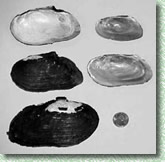| |
Mussel Mysteries
 By
Paul Lauenstein & Kurt Buermann By
Paul Lauenstein & Kurt Buermann
The freshwater mussel provides a good example of the interrelationships
that go on “behind the scenes” in nature. Mussels live
for a surprisingly long time—some as long as half a century.
Their age can be estimated by counting shell ridges, much as we can
tell the age of trees from growth rings.
To reproduce, freshwater mussels depend on fish. The female mussel
broods larvae, called glochidia, within her shell. When she releases
them, they fasten onto the gills and fins of certain fish. The glochidia extract nutrients from the host fish’s blood. In a few weeks
they are ready to go it alone and drop to the bottom to begin their
adult lives, filter-feeding on plankton in the water. As filter feeders,
mussels are good indicators of the presence of pollutants in the
body of water they inhabit.
If the glochidia larvae did not “hitch a ride” on fish,
they would be swept downstream by the current. The parasitic phase
of the mussel life cycle assures that mussels will be dispersed upstream
as well as downstream.
Now, the funny thing is that the larvae of each species of mussel
go for specific types of fish as hosts. When herring and alewives
were able to reach Sharon’s now-inaccessible (due to dams on
the Neponset River) Lake Massapoag, a type of mussel known as the
alewife floater could live there. Since alewives no longer reach
the lake, the alewife floater mussel has disappeared as well.
In 1989 the Town of Sharon constructed a well field on the shore
of Gavin’s Pond. Since then, the outflow stream from Gavin’s
Pond has dried up every summer. Freshwater mussels (elliptio
complanata)
that lived in the outflow pool died off. Some of these mussels were
several decades old. This species relies on yellow perch, sunfish,
and largemouth bass to complete their life cycle. Fish remain in
the pond, but any fish that escape downstream are eradicated every
summer when the stream dries up.
In the United States about 300 species of mussels can be found. Because
of dams, pollution, and past over-harvesting (the use of shells to
make buttons) many mussel species are endangered. In Massachusetts
seven of 12 freshwater mussel species are protected by the Massachusetts
Endangered Species Act.
If you are interested in mussels as well as other denizens of Sharon’s
Lake Massapoag, there is now an informational kiosk with descriptions
and pictures of aquatic life in the lake. It is located at the Pond
and Beach Street rotary near the boat ramp area.
Back to Items of Interest
|
|